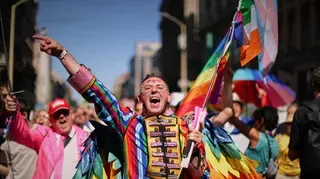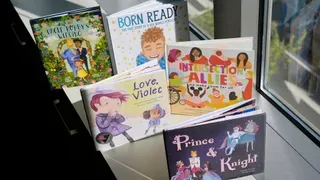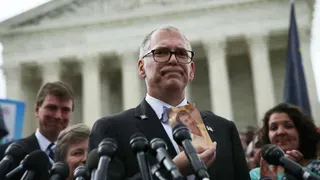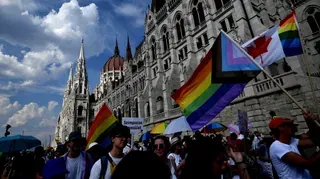December 1, 2010
How to Stem Gay People of Color's High HIV Infection Rates
Michael D. Shankle and Uriah Bell READ TIME: 4 MIN.
C. Everett Koop first sounded the alarm about AIDS when he was the U.S. Surgeon General for President Reagan in the late-1980s. He rang it again this month when he described AIDS as a "forgotten epidemic" and warned that complacency about AIDS is just "as dangerous as the irrational fear in the early days" of the epidemic.
Complacency, fear, and a lack of knowledge about how HIV is transmitted has fed high infection rates among gay/bi men in the U.S. But as bad as the numbers are, they're even worse for gay/bi communities of color.
Although white gay and bisexual men represent the vast majority of HIV/AIDS cases nationally, black and Hispanic men are disproportionately impacted. Black men age 13 to 29 who have sex with men are nearly twice as likely to be diagnosed with HIV as their white and Hispanic counterparts. And black and Hispanic gay and bisexual men are more likely to be infected at a younger age than white gay and bisexual men.
"An Added Burden: The Impact of the HIV/AIDS Epidemic on Communities of Color in Massachusetts," a 2007 report from the Massachusetts Department of Health, starkly explains why black and Hispanic men are harder hit by HIV: "Stigma surrounding HIV/AIDS and the behaviors that transmit HIV, lack of knowledge about HIV and AIDS risk, the relative lack of culturally and linguistically appropriate services, the under-representation of members of communities of color in HIV/AIDS services, and the compounding effects of the mistrust of the medical and public health system."
When you couple that with the fact that black and Latino gay and bisexual men of color have been inundated with messages that they are "sexual deviants" from multiple sources, sometimes including churches and their families, you have a recipe for further marginalization.
High HIV transmission rates become almost self-perpetuating when you factor in a particular community's infection rate. As "An Added Burden" puts it: "In communities with higher HIV prevalence, the same act of unprotected intercourse carries a greater level of risk of transmission than in populations with lower overall prevalence of the virus."
So: What to Do About It?
For starters, we need more direct services and rapid HIV testing made available in communities of color. Problems with our health care system have been widely documented elsewhere. But it is worth repeating that one of the consequences of a lack of providers who reflect the community members most in need of care is that these men are less likely to access clinical settings for HIV testing, much less make -- and keep -- doctors' appointments.
We need targeted, research-based prevention messaging that's been developed by members of the community. These messages must make use of the visual images, values, and traditions of the multiple communities that gay/bi men of color live in.
We need vastly expanded HIV education and outreach into gay/bi male communities of color via social networks and the media to leverage the strength that already exists within these networks. We have to foster activism and reinvestment in the fight to end HIV.
We need to work toward a more tolerant society, one in which men feel comfortable being open about who they are and who they love. This cannot be accomplished solely from the desks of researchers and policy makers.
It must come from all of us. And it's important to acknowledge how racism and homophobia fuel the AIDS pandemic. Racism, in particular, can leave an individual feeling little opportunity to be open about the complexities of his life, and thus more risk for HIV transmission.
Conflicts About Disclosure -- To Oneself & Others
We need to address the reasons why more men are not out about who they are -- be it their sexual orientation or HIV status, whether positive or negative. Disclosure is not an easy task.
There has always been an internal conflict with when and how to disclose one's status. It is a challenging dilemma (and in some state's mandated by law) to disclose that you are HIV positive prior to engaging in a sexual act. ? Do you disclose immediately and risk someone "outing" you with regard to your status? Or do you disclose after you've established a level of trust and risk destroying that trust?
Stigma and shame play a major role in perpetuating the cycle of HIV transmission. The most effective way to break that pattern is with honest discussions about HIV and openness around HIV status.
Openness about HIV means delivering honest messages about what HIV looks like. In the last 15 years, we affiliated HIV with the sexy boy next door in amazing shape with a killer smile. Before that, HIV had a frightening face. It would be irresponsible to go back to those images, but HIV is not all six-pack abs; we should be showing the real effects of the virus on the human body.
We do not believe that HIV is a "forgotten epidemic" as Koop describes. We believe it's dropped off the list of priorities. HIV lacks the urgency it once held in so many of our lives. To end the pandemic, we will have to recommit to community-based action to reduce the spread of HIV.
Even with amazing advances in biomedical science, such as that announced November 23 about a daily pill that can significantly reduce an individual's risk for HIV infection, we aren't going to win the battle against HIV with out this kind of action.
In the meantime, learn about to protect yourself. Get tested. Talk to your friends and family about HIV. These small actions add up. Collectively, they can change a community's response to HIV. And when that happens, we can use the strengths of our communities as a platform on which to educate those who are yet to be our allies.
Michael D. Shankle, MPH is the director of Gay, Lesbian, Bisexual, and Transgender Health at AIDS Action Committee of Massachusetts. Uriah Bell is a member of the Board of Directors for the Hispanic Black Gay Coalition and is the committee chair for HIV/STD Prevention and Outreach.







